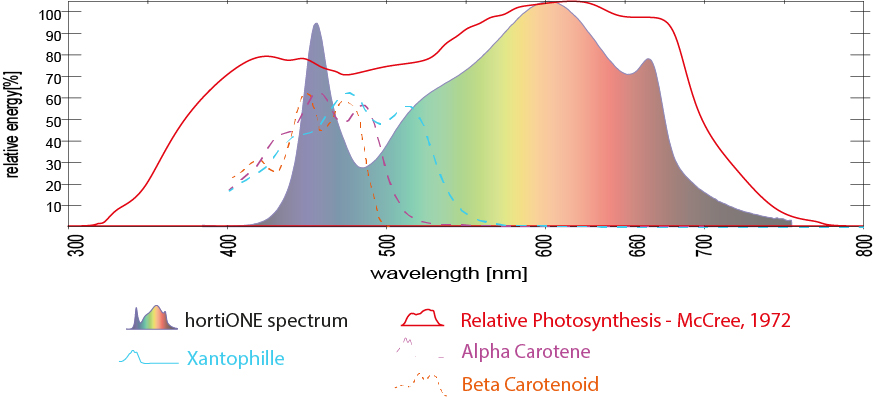Light Spectras and Absorption Curves for horticulture
When we talk about plants and their interaction with light, we mostly talk about photosynthesis. But this is only a small part of the story, there are numerous other mechanisms controlled by light.
This article aims to help understanding the different mechanisms. Due to the complexity, we just give an overview of the interaction of absorption spectra.
It is important to differentiate between absorption spectra and emission spectra. E.g Sunlight or hortiONE LED grow lights emit light in a specific spectrum. The measured absorption curves illustrate which wavelength triggers and activates a corresponding process.
- Alle Spectras are shown in relation to their 100% relative energy – therefore do not compare the height of an absorption curve to the emission curve.
- Absorption is not always 100% the same, it relies on the species, nutrient level, saturation, and more
Photosynthesis
Chlorophyll a/b
Chlorophyll is a part of chloroplast and is the light-absorbing pigment that provides green color to the plants. Chloroplasts are plant cell organelles that traps and convert light energy into chemical energy via the photosynthetic process. Other Chlorophylles than a/b are mainly present in algae and cyanobacteria.
McCree defined the McCree Curve after testing the photosynthesis ratio of numerous plants. This is often considered the “photosynthesis curvee”. (More info and the full article can be found here)

Different Photosynthesis Curves
The picture below shows two different photosynthesis absorption curves:
- McCree (1972) is most often used as the general photosynthethic absorption curve. McCree also defined the common PAR (400-700nm) range.
- Hoover (1937) defined the photosynthetic absorption curve earlier. It is considered outdated due to the McCree curve.
- Sunlight spectrum as a reference, as sunlight is still the most efficient spectrum and all plants have developed under sunlight for millions of years.

Phytochromes
Phytochromes are photoreceptors used to detect light. They are sensitive to red and far-red light.
Relevant processes are
- The Phytochrome conversion (Pfr to Pr) allows the plant to sense when it is night or day.
- Emmerson Effekt (Emmerson enhancement effect) which increases photosynthesis rate. botanydictionary.org/emerson-effect
- Photomorphogenesis: The Pfr / Pr ratio also controlls the shade avoidance which leads to elongation academic.oup.com
- Phytochromes regulate the germination of seeds (photoblasty) and the synthesis of chlorophyll.

Carotenes and Colors
The carotenoid family contains more than 600 types of carotenoids.
The difference between carotenoids and carotenes is chemical. Xanthophylls contain oxygen, while Carotenes are hydrocarbons and do not contain oxygen. Also, they absorb different wavelengths of light. Xanthophylls are more yellow, while Carotenes are orange.
- β-Carotene is an organic, strongly colored red-orange pigment abundant in fungi, plants, and fruits. It is a member of the carotenes, which are terpenoids.
- α-Carotene is a form of carotene with a β-ionone ring at one end and an α-ionone ring at the opposite end. It is the second most common form of carotene.
- Both alpha and beta Carotene are important as precursors for vitamin A
- Xanthophylls are yellow pigments that occur widely in nature and form one of two major divisions of the carotenoid group. Origin of the name is from Greek Xanthos (yellow) and phyllon (leaf)
- Carotenes are antioxidants and deactivate free radicals.

Flavoproteins and other Photoreceptor Proteins
Anthocyanins are a type of flavonoid with antioxidantic effects. They are red, blue, and purple pigments that give plants their specific color. The given color is depending on the pH-Level and reaches up to black color. Samples are blueberry, raspberry, black rice, black soybean, and purple cauliflower as well as many others.
Zeaxanthin is one of the most common alcohols found in nature. It is important in the xanthophyll cycle. Synthesized in plants and some micro-organisms, it is the pigment that gives paprika, corn, saffron, wolfberries, and many other plants and microbes their characteristic color. More Info on Wikipedia
Cryptochromes are photoreceptors that regulate entrainment (reset of the internal clock) by light of the circadian clock in plants and animals. They also act as integral parts of the central circadian oscillator in animal brains and as receptors controlling photomorphogenesis in response to blue or ultraviolet (UV-A) light in plants.
More: genomebiology.biomedcentral.com/articles/10.1186/gb-2005-6-5-220
Phototropins are blue light receptors for phototropism, chloroplast movement, leaf expansion, and stomatal opening. These responses aid photosynthesis in efficiently obtaining light, decreasing photodamage and acquiring CO2.
